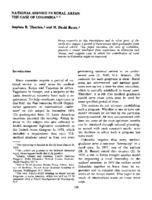National service in rural areas: the case of Colombia
| dc.contributor.author | Thacker, Stephen B | es_ES |
| dc.contributor.author | Banta, Henry David | es_ES |
| dc.date.accessioned | 2016 | |
| dc.date.available | 2016 | |
| dc.date.issued | 1976 | es_ES |
| dc.identifier.uri | https://iris.paho.org/handle/10665.2/27661 | |
| dc.description.abstract | Sending new medical school graduates into rural areas does give underserved populations access to modern medical care, perhaps for the first time. However, these young physicians usually spend most of their time providing strictly clinical services and are generally eager to leave at the end of their assignment. Some have referred to this practice as «parachuting» a doctor into an underserved area. An alternative is to focus first on building up permanent health service facilities in rural areas that are staffed by appropriate paraprofessionals. The young physician can then play a much more important role, serving as an administrator, researcher, evaluator, and teacher of the local staff; his clinical activities would generally be confined to the more complicated medical problems that arise. Such a model has been implemented in Kenya and Tanzania. An informal field assessment in Colombia has indicated that this model could be effectively applied there as well; indeed, it has been the hope of Colombian policymakers that the rural intern would function in such a way. However, this would require developing the nation's system of health services, as well as providing specific training aimed at preparing the medical student to perform his assigned role (Au) | en_US |
| dc.relation.ispartofseries | Bulletin of the Pan American Health Organization (PAHO);10(2),1976 | en_US |
| dc.subject | Internship and Residency | en_US |
| dc.subject | Rural Health | es_ES |
| dc.subject | Colombia | es_ES |
| dc.subject | Kenya | es_ES |
| dc.title | National service in rural areas: the case of Colombia | es_ES |
| dc.type | Journal articles | en_US |
| dc.rights.holder | Pan American Health Organization | en_US |
Files in this item
This item appears in the following Collection(s)
-
Pan American Journal of Public Health
Revista Panamericana de Salud Pública




